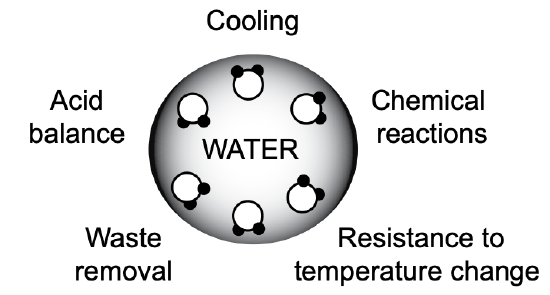12.9: Summary
- Page ID
- 57720
Water is an important nutrient that’s often overlooked in discussions of diet and nutrition. Yet our bodies are more than 50% water, and unlike the other nutrients, we can’t survive more than a few days without it. Water works by acting as a solvent, allowing chemical reactions to take place, and also takes part in many of our biochemical reactions.
Our bodily water is both intracellular and extracellular, constantly moving, along with other dissolved substances, in and out of our cells. The amount of water in an adult body is inversely related to the amount of body fat. Also, when we lose muscle mass (as in aging), we lose the water that’s in that muscle.
Some of our body water can be lost or gained relatively quickly, from things like water intake, hormones, sodium, diuretics, exercise, and diet. Much of the quick weight loss that occurs within a few days of starting a diet or after exercising is really from water loss.
Water is critical for maintaining body temperature and also for removing body wastes and extraneous substances. Evaporation of perspiration cools our bodies, and occurs almost constantly. Removal of wastes and extraneous substances occurs through urine (waste products are dissolved and excreted in urine using relatively large amounts of water) and feces, which contain water. Diarrhea can cause enough water loss to endanger life.

Body water is regulated by the kidneys and our brain’s thirst center. Urine will become concentrated if water intake is too low, and dilute when we get more than we need. When intake is too low, we become dehydrated, which can lead to heat exhaustion and eventually heat stroke, as the body loses its ability to regulate temperature. This can be fatal, and emphasizes the importance of drinking enough liquids, particularly in hot weather and during heavy exercise.
Because many variables can alter water balance, there’s no specific daily requirement for water. But in general, about a quart of water is needed for each 1,000 calories consumed. In addition, to drinks, the water in “solid” foods counts, as does the water produced when energy-providing nutrients are metabolized.
Athletes can have special water needs, especially in hot weather, and thirst isn’t a reliable gauge of need. Any advantage conferred by “sports drinks” will generally be due to their carbohydrate content, and will be limited to endurance events lasting more than 90 minutes. While drinking enough water is important, it’s also important to not drink too much.
Much of the water we consume is in food, which is roughly 50% water. Even solid-appearing foods have a lot of water, as their fibrous structures hide the liquid inside. Because water represents so much of food, it must be considered when measuring calorie content or food value.
Most of our drinking water is safe. Hazardous contaminants tend to be localized, as in water from wells in certain areas.
Fluoride in water helps protect against tooth decay, whereas minerals such as calcium and magnesium make the water “hard.” Bottled water, in general, is processed tap water, or spring water, and some may have added carbonation and relatively high levels of sodium. Tap water and bottled water must meet the same Environmental Protection Agency standards.


